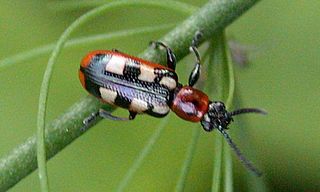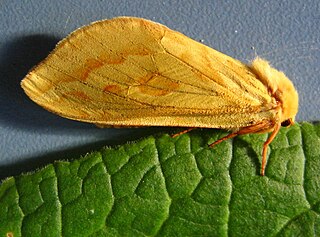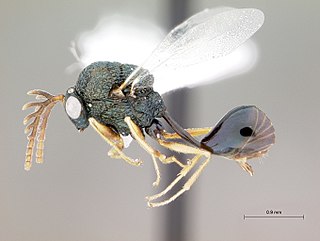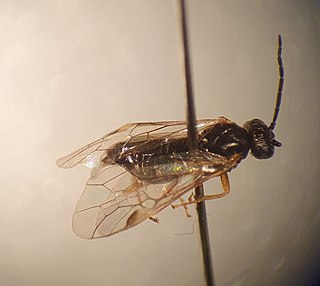
The common asparagus beetle is an important pest of asparagus crops both in Europe and in North America. Asparagus is its only food plant. The beetle is 6.0 mm to 9.5 mm long and slightly elongated. It is metallic blue-black in color with cream or yellow spots on its red-bordered elytra. The larvae are fat gray grubs with dark heads.

The ghost moth or ghost swift is a moth of the family Hepialidae. It is common throughout Europe, except for the far south-east.

Laothoe populi, the poplar hawk-moth, is a moth of the family Sphingidae. The species was first described by Carl Linnaeus in his 1758 10th edition of Systema Naturae. It is found throughout the Palearctic region and the Near East and is one of the most common members of the family in the region. It is distinctive due to its habit of resting with its hindwings held further forward than the forewings.

The large copper is a butterfly of the family Lycaenidae. L. dispar has been commonly arranged into three subspecies: L. dispar dispar, (single-brooded) which was commonly found in England, but is now extinct, L. d. batavus, (single-brooded) can be found in the Netherlands and has been reintroduced into the United Kingdom, and lastly, L. d. rutilus, (double-brooded) which is widespread across central and southern Europe. The latter has been declining in many European countries, due to habitat loss. Currently L. dispar is in severe decline in northwest Europe, but expanding in central and northern Europe.

Phyllophaga is a very large genus of New World scarab beetles in the subfamily Melolonthinae. Common names for this genus and many other related genera in the subfamily Melolonthinae are May beetles, June bugs, and July beetles. They range in size from 12 to 35 mm and are blackish or reddish-brown in colour, without prominent markings, and often rather hairy ventrally. These beetles are nocturnal, coming to lights in great numbers.

The Eucharitidae are a family of parasitic wasps. Eucharitid wasps are members of the superfamily Chalcidoidea and consist of three subfamilies: Oraseminae, Eucharitinae, and Gollumiellinae. Most of the 55 genera and 417 species of Eucharitidae are members of the subfamilies Oraseminae and Eucharitinae, and are found in tropical regions of the world.

The orange swift or orange moth is a moth belonging to the family Hepialidae. The species was first described by Carl Linnaeus in 1761 and was previously placed in the genus Hepialus. It is distributed throughout Europe.

Cotinis nitida, commonly known as the green June beetle, June bug or June beetle, is a beetle of the family Scarabaeidae. It is found in the eastern United States and Canada, where it is most abundant in the South. It is sometimes confused with the related southwestern species figeater beetle Cotinis mutabilis, which is less destructive.

The Chrysomelinae are a subfamily of leaf beetles (Chrysomelidae), commonly known as broad-bodied leaf beetles or broad-shouldered leaf beetles. It includes some 3,000 species around the world.

Pachnoda marginata is a beetle from the subfamily Cetoniinae with a large number of subspecies that lives in west and central Africa. They are sometimes used as food for terrarium animals. The adult beetles are 20–30 mm, the larvae are very small when they hatch, but can grow as long as 60 mm. It is commonly called the sun beetle or Congo chafer beetle.

Acronicta rumicis, the knot grass moth, is a species of moth which is part of the genus Acronicta and family Noctuidae. It was first described by Carl Linnaeus in his 1758 10th edition of Systema Naturae. It is found in the Palearctic region. A. rumicis lives and feeds on plants located in wide-open areas. At its larval stage, as a caterpillar, it causes such a large impact as a crop pest that it has received much attention and research. A. rumicis feeds on maize, strawberries and other herbaceous plants.

Adscita statices, the green forester, is a moth of the family Zygaenidae. It is found in Europe, Mongolia and western Russia.

Xanthogaleruca luteola, commonly known as the elm-leaf beetle, is a beetle species in the family Chrysomelidae that is native to Europe but invasive in other parts of the world.

Enteucha acetosae, the pygmy sorrel moth, is a moth of the family Nepticulidae found in Europe. It is one of the smallest moths in the world with some having a wingspan of only 3mm. The larvae mine the leaves of docks, leaving bright red tissue around the mines.

Chrysochus auratus, the dogbane beetle, of eastern North America, is a member of the leaf beetle subfamily Eumolpinae. It is primarily found east of the Rocky Mountains. Its diet mainly consists of dogbane (Apocynum), specifically Apocynum cannabinum and Apocynum androsaemifolium, and occasionally it eats milkweed. It is 8-11 mm long and has a convex, oval shape.

Apion apricans is a species of seed weevils native to Europe. It is widespread everywhere. Damages clover and wild. The beetle is 3–3.5 mm in size, black, with a metallic hue, the body is pear-shaped, the legs are partially yellow; rostrum long, almost straight; apex of antennae black, base - red. Egg - 0.3-0.5 mm, yellowish, long, smooth. Larva 2–2.5 mm, white with a creamy hue, curved, dark brown head, on the upper jaws on each side of three growths, the middle of them increased; instead of legs six pairs of small knolls. Pupa 3–3.5 mm, yellowish white.

Euura proxima is a species of sawfly belonging to the family Tenthredinidae. The larvae feed on the leaves of willows, creating galls and was described by Jean Guillaume Audinet-Serville in 1823.
Euura bridgmanii is a species of sawfly belonging to the family Tenthredinidae. The larvae feed on the leaves of sallows. It was first described by the entomologist Peter Cameron in 1883.
Euura vesicator is a species of sawfly belonging to the family Tenthredinidae. The larvae feed internally in a gall on the leaves of purple willow and its hybrids. It was first described by Johann Jacob Bremi-Wolf in 1849.

Lamprolina is an Australian genus of leaf beetles (Chrysomelidae) found in Victoria, New South Wales, and Queensland.






















